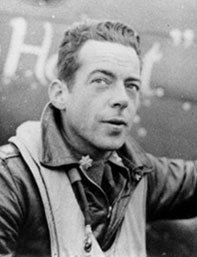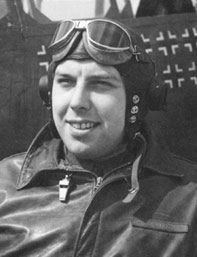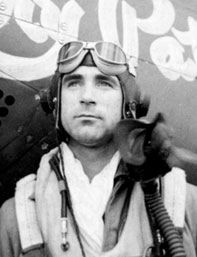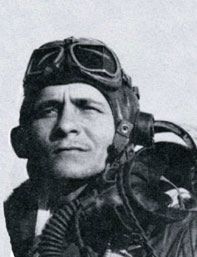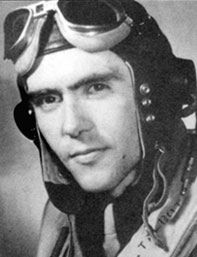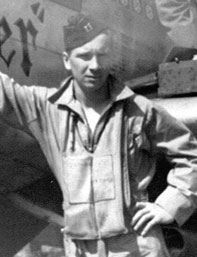Birth of the Pugnacious Pups
By 1st Lt. Donald F. Snow
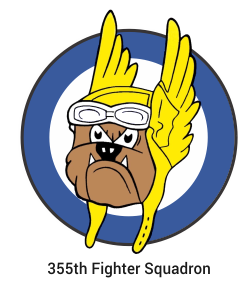
When he was given the assignment of organizing and training fighter-pilots and men for combat, the nucleus of the 355th Fighter Squadron, at Hamilton Field, California. Captain George R. Bickell was looking toward the Land of the Rising Sun. He hoped that through his leadership, his pilots would make a name for themselves in smashing back at the Jap. This month of November, 1942 was less than a year after the Pearl Harbor disaster. Captain Bickell had seen that holocaust and had flown P-40 aircraft off Navy carriers during the Battle of Midway. But there was another Big League shaping up in the skies of Europe in which he was to play a major role. "Uncle George", Commanding Officer of the 355th Squadron, was slated to eventually be Group Commander of the Pioneer Mustangs, not only in the latter days of the Air Battle over Germany, but as the Pioneers supported the Army in the invasion of France. He would stand before this Group on May 7, 1945 to announce to his men the Victory in Europe.
Organization at Hamilton Field was completed by the middle of January 1943. An advanced detail of officers and men were sent to the Tonopah, Nevada, Bombing and Gunnery Range for training in P-39 Airacobra aircraft.
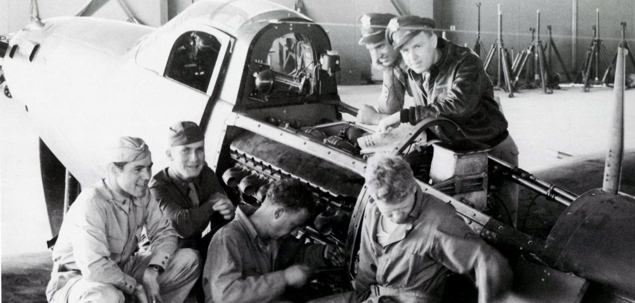
355th squadron mechanics work on a P-39N Airacobra while pilots look on. The 355th FS was based in Portland, Oregon for final training before going overseas. (National Archives)
Second Lt. Bowers Espy, Squadron Adjutant, established a working administrative system and basic training program for the enlisted men of the squadron. During this transition period, in the lonely, barren desert country, new friendships sprang up; the new Squadron insignia, the "Pugnacious Pup," stamped an individuality of intrinsic value into the growing 'esprit de corps' of the 355th Squadron.
-
See 355th Fighter Squadron Reproduction Insignia
+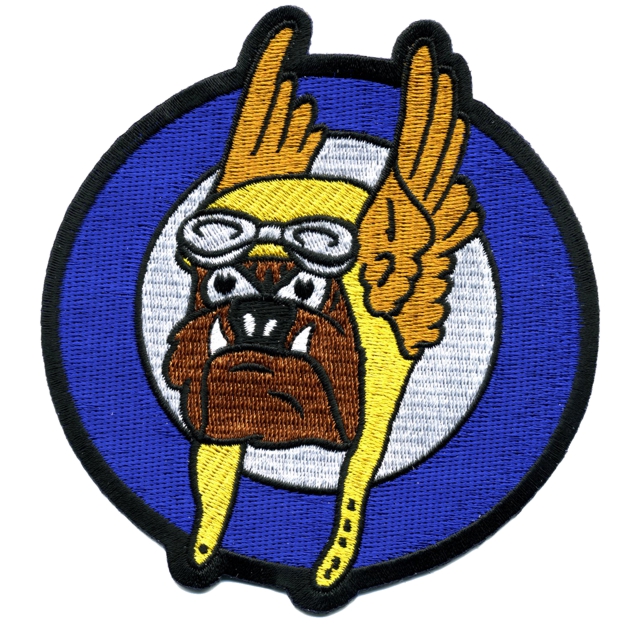
A high quality reproduction patch of the 355th Fighter Squadron "Pugnacious Pup" insignia was commissioned by Jeff W. Stephens, son of the late Col. Robert W. Stephens. The patch is being used in a shadow box along with photos and his father's World War II medals. This stunning patch measures 4-1/2 inches in diameter.
On the first of March, with gunnery training completed, the officers and men of the 355th Squadron, now better acquainted, moved on to another station. The new set-up at Hayward Army Airdrome, Hayward, California developed within the outfit a rich personality. The 355th was to continue as a very separate and distinct entity for awhile . . on its own. It was an unique opportunity to operate 80 miles apart from the parent Group and affiliated squadrons at Santa Rosa, Calif. At Hayward the Squadron attained the Group's highest training efficiency record, proving that the almost laissez-faire policy of Group was actually an incentive to the men of the 355th Squadron. Americanly, freedom was appreciated obvious by the outstandingly superior work accomplished at Hayward.
By the first of June our personnel, ready for final training, moved to Portland, Oregon Army Air Base. Many new pilots were joined to train for combat. By intense work, loyalty and cooperation in every department an impressive and highly commendable record was attained by the Pugnacious Pups as they readied themselves for the big job ahead. Flights were being made to all points in Oregon and some missions even took the pilots out to sea. We were a part of the defense set-up in the Northwest, being on the alert for possible attacks by units of Emperor Hirohito's dishonorable fleet. On the 18th of August the Squadron moved to Troutdale, Oregon, for maneuvers to simulate combat conditions. With this experience, the junior pilots had completed the last course in the training program qualifying them for combat.
Portland to Colchester
September was the month of parties and goodbyes. Wondering, speculating as to whether crossing the Atlantic or the Pacific was in the offing. On October 6th we departed from Portland, Oregon, by train, making our way across the United States to Camp Kilmer, New Jersey. On October 20th, after being refitted at Kilmer, we walked up the gangplank into the liner Athlone Castle. We were headed for England, a large number of merchant ships made up convoy, we were protected by men-of-war. Everyone was glad to see Liverpool. After two weeks at sea in crowded, uncomfortable quarters, stepping on solid earth was quite a satisfaction.
Greenham Commons was the first stop, affording a slight orientation to life in England before we journeyed to Colchester, in East Anglia, the site of one permanent station, Boxted Airdrome.
On the 16th of December, near Bremen, Germany, Lt. Charles F. Gumm shot down the first enemy plane to be destroyed by the P-51B Mustang.
Scarcely two weeks after getting settled in the cold, damp Nissen huts at Boxted, the pilots of our Squadron had completed transition training with a new type fighter, the P-51B.
Our first mission was flown on the first of December. Led by Lt. Col. Don Blakeslee of the 4th Fighter Group, the Group flew over St. Omer airdrome in France. The 355th Squadron line-up, headed by Major Bickell, included Lts. M.G. Long, "Deacon" Talbot, "Bob" Stephens, "Cousin" Lasko, "Peter" Nacy, Crocker, Dieterich and Pate.
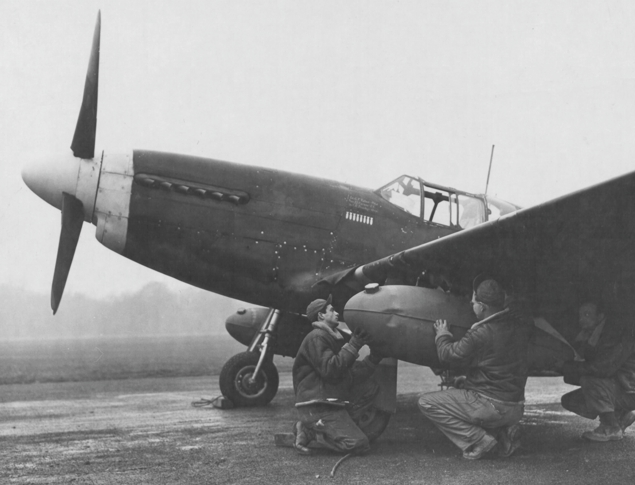
With the addition of a 85-gallon fuel tank behind the pilot, internal fuel capacity reached 184 gallons and combined with drop tanks pushed the P-51B Mustang's effective range was over 1,300 miles. Ground crew are fitting 78 gallon drop tanks to a Mustang belonging to the 355th in preparation for a long-range escort mission from Boxted. (National Archives)
On December 13, just a month after the first pilots had checked out in the Mustang fighter, we made history by escorting bombers all the way to Kiel, Germany. On the 16th of December, near Bremen, Germany, Lt. Charles F. Gumm shot down the first enemy plane to be destroyed by the P-51B Mustang.
In the first month of 1944, our pilots were probing even more deeply Krautland, with missions being flown to Frankfurt, Brunswick and the Halberstadt-Oschersleben area. Lt. "Red" Emerson's plane got very badly shot-up over Kiel. "Red" brought it back safely, although the Mustang looked like a sieve. A piece of shrapnel had made an ugly gash on his neck; his parachute harness had been severed by another hunk of steel. Dazed and weakened by loss of blood, Emerson flew his plane across the North Sea to England, landing his craft without the aid of brakes, in extremely poor visibility.


